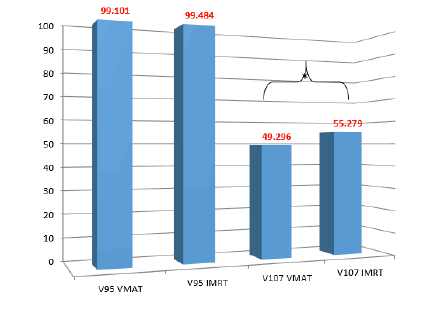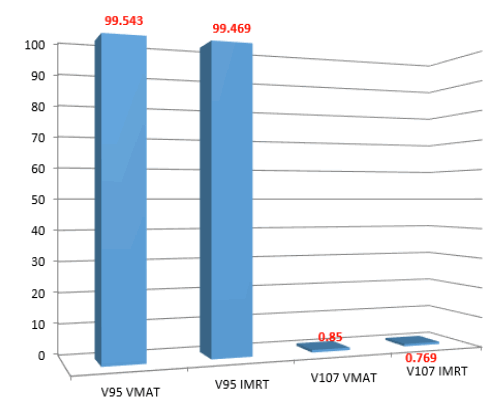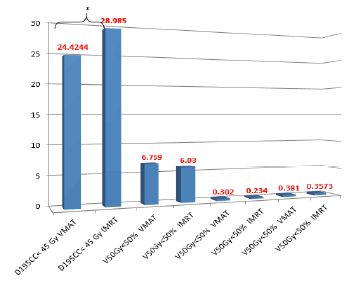Research Article - Onkologia i Radioterapia ( 2023) Volume 17, Issue 9
Comparison of volumetric arc (VMAT) and intensity-modulated radiation treatment for pelvic lymph nodes and bladder cancer
Manar M. Al Rubaie*, Mustafa S. Al Musawi and Dr Ammar Rasoul MohammadManar M. Al Rubaie, Physiology and medical physics department, College of Medicine, Almustansiriyah University, Baghdad, Iraq, Email: manaralrubaie84@gmail.com
Received: 06-Jul-2023, Manuscript No. OAR-23-112100; Accepted: 31-Aug-2023, Pre QC No. OAR-23-112100 (PQ); Editor assigned: 28-Jul-2023, Pre QC No. OAR-23-112100 (PQ); Reviewed: 10-Aug-2023, QC No. OAR-23-112100 (Q); Revised: 26-Aug-2023, Manuscript No. OAR-23-112100 (R); Published: 02-Sep-2023
Abstract
Background: Bladder cancer is an intricate disease associated with high morbidity and death- rates if not treated optimally. The three main components of treating bladder cancer are surgery, chemotherapy, and radiation therapy. When used for local recurrence control, external beam radiation is highly effective. The purpose of this study is to compare the benefits of using the Volumetric Arc Therapy (VMAT) technique to those of using the Intensity Modulated Radiotherapy (IMRT) technique for treating patients with bladder cancer, specifically with regard to achieving a homogeneous dose distribution for the tumor while also minimising the dose to the organs at risk. Material and Method: Patients with bladder cancer and positive lymph node were eligible for the study. This planning using IMRT and VMAT will be design to deliver 60GY to the PTV bladder cancer and 50GY to the PTV positive lymph node. The dose volume histograms were apply to quantitative evaluation of the treatment plans, including PTV, rectum, intestine, head of femur . Results: This planning for the IMRT and VMAT for PTV50 where 95% p-value (0.109) and 107% the VMAT p-value (0.006). When dose PTV60 were 95% and 107% the p-value (0.678, 0.768). The organ at risks (OARs) plan dose (intestine, rectum, RT. Head Femoral, LT. Head Femoral) that techniques IMRT and VMAT p-value (0.016, 0.146, 0.387, and 0.609). Conclusions: Our research indicates that VMAT is the most appropriate method for this time period when compared to IMRT.
Keywords
bladder Cancer, Intensity Modulated Therapy, Volumetric Modulated Therapy
Introduction
The lower urinary tract is in charge of holding onto and periodically eliminating urine as a liquid waste product from the body. The urethra and urine bladder make up the lower urinary tract. A base made up of the trigone and bladder neck and a body that lies above the ureteral orifices make up the bladder, in terms of neuromorphology and neuropharmacology, the two fields are distinct but similar to one another. Bladder cancer is an intricate disease associated with high morbidity and deathrates if not treated optimally. Bladder cancer is the fourth most frequent cancer in males and the eleventh most prevalent cancer in women, with than 430 000 patients globally receiving a diagnosis each year. External beam radiation is a successful bladder-substitute for cystectomy in the treatment of bladder cancer. Domestic control rates of 67% were attained for focal tumors using a combination of whole bladder irradiation, a tumor boost, and chemotherapy. The option used for treat bladder cancer the radiation therapy. Radiation therapy Highenergy radiation is used in radiation therapy to repair DNA damage in cancer cells. Since radiation at high doses works to murder cancer cells and stop them from growing and replicating, in radiation therapy, cancer cells are either killed or infected in order to prevent their growth. External radiation therapy aims to provide a high dose to the tumor while minimizing the dose to healthy tissue nearby.
External radiation therapy techniques
One of the most significant developments in oncology during the past ten years has been Intensity-Modulated Radiotherapy (IMRT). This innovative therapeutic modality has quickly developed because of advancements in computer technology and imaging methods (Taylor and MEB Powell 2004). With IMRT, radiation is given to the patient through fields with irregular radiation fluence with the advent of IMRT, it is now possible to produce dramatically enhanced dosage distributions that can be adjusted to match intricate designs. They are intended to meet the predetermined dose requirements for the tumor site and the nearby healthy tissues. The distribution of dosage around the target and the homogeneity of the dose within the target can be controlled more effectively by varying both the number of treatment fields and the intensity within each field [1-4].
Volumetric Modulated Arc Therapy (VMAT) is a revolutionary radiation technology that, when compared to standard radiotherapy methods, can generate highly conformal dose distributions with enhanced target volume coverage and sparing of normal tissues. Volumetric Modulated Arc Treatment (VMAT) involves treating the patient with one or more gantry arcs with continuously altering beam aperture, gantry speed, and dose rate. A quick and highly conformal treatment administration is achieved with VMAT by dynamically varying the gantry speed, Multi Leaf Collimator (MLC) leaf location, and dose rate during gantry rotation. This study aimed to assess the efficiency of Volumetric-Modified Arc Therapy (VMAT) and Intensity-Modulated Radiotherapy (IMRT) in reducing radiation exposure to the rectum, intestine, and head of the femur in patients with bladder cancer [4, 5].
Materials and Methods
All 10 patients’ images will come from a bladder cancer protocol that will be approved by human ethics.
CT simulation
Computed tomography simulation (CT simulation) Phlips as a first step after confirming that the member is infected for each patient to obtain 3D anatomical data for treatment planning purpose. The patient immobilization was with ankle stocks and bolster the knees. Before the CT (simulation) there are recommendations for all pation’s must be implemed. The recommendation’s (fasting, full bladder, empty rectum & drinking water 200cc before imaging 30 min.
Delineation (contouring)
The data of patient transport from work station of CT simulation to the Monaco station the oncologist contouring to the Target Volumes (TVs) and Organ at Risks (OARS) on CT image.
1. The CTV and PTV of the bladder cancer
2. The CTV and PTV of the lymph node
3. The organ at risks (OARs) (rectum, intestine, RT head femrol, LT head femrol)
Treatment planning system (TPS)
After oncologist completes the contouring and determine the prescribed dose for the target. Choosing the treatment planning technique, which is that contain two types (Dynamic MLC IMRT SIB, VMAT SIB). All treatment plans IMRT and VMAT will be designed to deliver 60GY to the bladder cancer consider the PTV in 25F and deliver 50GY to the lymph node consider the PTV total in 25F in this study. Including PTV, the rectum, the intestine, and the head of the femur, the dose volume histograms were used to evaluate the treatment plans quantitatively
Statistical analysis
The statistical software tool Statistical Packages for Social Sciences, version 24 (SPSS-24), was used to analyse the data. Using the Student's test for the difference and the Paired test for a difference of paired observations, the significance of the difference of various means (quantitative data) was examined. For correlation, a scattering distribution curve was used. When the p value was 0.05 or less, statistical significance was taken into account [6-8].
Results
Table 1 and Figure 1 show that IMRT plans increase dose for PTV 50 GY when compared to VMAT plans, with 95% of the required dose covering 95% (V95) of PTV 50 GY, but there is no statistically significant difference with PValue (0.109). However, for 107% of prescribed dose the VMAT plan has clear advantage in decrees high dose for PTV 50 GY P Value (0.006) [9-12].
Tab. 1. Descriptive of PTV 50 GY
| Mean+ SD | P-value | ||
|---|---|---|---|
| PTV 50 GY | V95 VMAT | 99.1010+ 1.8223 | 0.109 |
| V95 IMRT | 99.4840+ 1.2397 | ||
| PTV 50 GY | V107 VMAT | 49.2960+ 15.3038 | 0.006* |
| V107 IMRT | 55.2790+ 15.3358 | ||

Figure 1: Represent Coverage of the tumor PTV 50 GY
Table 2 and Figure 2 showed there is no significant difference between two techniques in coverage dose for PTV 60 GY where P-Value (0.678) [13]. However, for 107% of prescribed dose here is no significant difference between two techniques Value (0.768).
Tab. 2. Descriptive of PTV 60
| Mean+ SD | P-value | ||
|---|---|---|---|
| PTV 60 | V95 VMAT | 99.5430+ 0.5356 | 0.678 |
| V95 IMRT | 99.4690+ 0.5614 | ||
| PTV 60 | V107 VMAT | 0.8500+ 1.2801 | 0.768 |
| V107 IMRT | 0.7690+ 0.7756 | ||

Figure 2: Represent Coverage of the tumor PTV 60 GY
Depending on Table 3 and Fig 3 the VMAT plan decrees dose for intestine compare with IMRT P Value (0.016) Moreover, for the (rectum, RT. Head of femoral, Lt. Head of femoral) there is no significant change between both techniques (IMRT, VMAT) in decrees dose where P value (0.146,0.387,0.609).
Tab. 3. Descriptive of Organ at Risk.
| Mean+ SD | P-value | ||
|---|---|---|---|
| Intestine | D195CC< 45 Gy VMAT | 24.4244+ 9.642 | 0.016* |
| D195CC< 45 Gy IMRT | 28.9850+ 9.949 | ||
| Rectum | V50Gy<50% VMAT | 6.7690+ 10.689 | 0.146 |
| V50Gy<50% IMRT | 6.0300+ 9.387 | ||
| Right Head Femeral | V50Gy<50% VMAT | 0.3020+ 0.955 | 0.387 |
| V50Gy<50% IMRT | 0.2340+ 0.719 | ||
| Left Head Femeral | V50Gy<50% VMAT | 0.3810+ 1.0325 | 0.609 |
| V50Gy<50% IMRT | 0.3573+ 0.96 | ||

Figure 3: Represent Organ at Risk
Discussion
The goal of this study is to maintain and improve PTV dosage coverage while reducing the dose to the nearby normal tissues. In this research presented our planning from a study of integrated lymph node and bladder IMRT and VMAT. Another study found that IMRT provides highly conformal dose distributions, achieves excellent geometric precision, and causes less injury to healthy tissues as compared to the 3-dimensional conformal method [14]. The damage to organs at risk is further reduced by improved radiation techniques, like VMAT, a new technology developed from IMRT that uses a single gantry rotation and creates an ideal 3-dimensional dose distribution. In our study, according to Table 1, both the VMAT and IMRT plans were enough to cover the necessary clinical (PTV 50), but there was no significant change between the two techniques P values (0.109). However, for 107% of prescribed dose the VMAT plan has clear advantage in decrees high dose for PTV 50 GY P Value (0.006). Moreover , (For PTV 60) Table 2 and Figure 2 showed there is no significant difference between two techniques in coverage dose for PTV 60 GY where P-Value (0.678) (0.768) [15-17].
Previous research found that when IMRT was used, dosages to critical organs at risk (ORs) such the intestine and rectum were lowered. At the same time, target conformity and homogeneity were improved. Previous studies have demonstrated a strong dose –volume relationship between the severities of diarrheal toxicity and irradiated intestine volume at different dose levels. Baglan KL et al. indicated a strong dose–volume relationship existing between the irradiated small bowel volume and acute diarrhea at all dose levels and they constructed a predictive model for acute toxicity. In current study depending on table 3 and Figure 3 the VMAT plan decrees dose for intestine compares with IMRT P Value (0.016). An another hand, Hysing report the IMRT sparing of the intestine and rectum persisted when the intra-fractional movements were analyzed on repeated CT scans. In our investigation, there was no significant difference in decrees dosage for rectum between both procedures (IMRT and VMAT, with a p-value of 0.146). Regarding sparing of OARs, IMRT plans were substantially superior to VMAT in terms of femoral head and normal tissue surrounding target volume values. In addition, the current study shown that there was no statistically significant difference in decrees dosage for femoral heads between IMRT and VMAT, with a p-value of (0.387, 0.609).
Another research when use IMRT and 3DCRT , has shown that the intestines and rectum can be spared significantly when IMRT is used to treat the bladder and lymph nodes at the same time. Combining IMRT with image guiding research into bladder cancer may help us narrow the treatment margins and safely increase the radiation dose. Optimal local management with little toxicity may be the consequence.
While another research between VMAT and IMRT use another organ, IMRT was found to be the most effective method in a separate investigation. Target coverage was similar across IMRT and SmartArc, while IMRT was more effective in terms of OARS and normal tissue sparing. Most clinically examined endpoints favoured IMRT and SmartArc over 3DCRT, as expected [18-20].
Conclusion
Our research indicates that VMAT is the most appropriate method for this time period. When compared to IMRT, the VMAT plan clearly has the advantage of prescribing a high dose for the lymph node while also prescribing a dose for the intestine. For bladder cancer and another at-risk organ, we showed that IMRT and VMAT schemes are equally effective in terms of dose.
References
- Beckel JM, Holstege G. The lower urinary tract. In The Rat Nervous System. Academic Press; 2015. pp. 247-263. [Google Scholar] [Cross Ref]
- El‐Badawi A, Schenk EA. Dual innervation of the mammalian urinary bladder: A histochemical study of the distribution of cholinergic and adrenergic nerves. Am J Anat. 1966; 119: 405- 427. [Google Scholar] [Cross Ref]
- Kamat AM, Hahn NM, Efstathiou JA, Lerner SP, Malmström PU, et al. Bladder cancer. Lancet. 2016; 388:2796-2810. [Google Scholar] [Cross Ref]
- Gakis G, Efstathiou J, Lerner SP, Cookson MS, Keegan KA, et al. ICUD-EAU International Consultation on Bladder Cancer 2012: radical cystectomy and bladder preservation for muscle-invasive urothelial carcinoma of the bladder. Eur Urol. 2013; 63:45-57. [Google Scholar] [Cross Ref]
- James N, Southgate E, Zarkar A. Bladder cancer. External Beam Therapy. 2012; 233. [Google Scholar] [Cross Ref]
- Abbood AA, Piatkevich M et al. The Use of Accelerated Fractionation Methods for Irradiation of Prostate Cancer: VMAT-SIB and IMRT-SIB. Eur J Mol Clin Med. 2021; 8. [Google Scholar] [Cross Ref]
- Beyzadeoglu M, Ozyigit G, Ebruli C. Basic radiation oncology. Berlin: Springer; 2010; 71. [Google Scholar] [Cross Ref]
- Taylor A, Powell MEB. Intensity-modulated radiotherapy—what is it? Cancer Imaging. 2004; 4:68. [Google Scholar] [Cross Ref]
- Elith C, Dempsey SE, Findlay N, Warren-Forward HM, et al. An introduction to the intensity-modulated radiation therapy (IMRT) techniques, tomotherapy, and VMAT. J Med Imaging Radiat Sci. 2011; 42:37-43. [Google Scholar] [Cross Ref]
- Elith C, Dempsey SE, Findlay N, Warren-Forward HM, et al. An introduction to the intensity-modulated radiation therapy (IMRT) techniques, tomotherapy, and VMAT. J Med Imaging Radiat Sci. 2011; 42:37-43. [Google Scholar] [Cross Ref]
- Bedford JL, Warrington AP. Commissioning of volumetric modulated arc therapy (VMAT). Int J Radiat Oncol Biol Phys. 2009; 73:537-545. [Google Scholar] [Cross Ref]
- Foroudi F, Wilson L, Bressel M, Haworth A, Hornby C, et al. A dosimetric comparison of 3D conformal vs intensity-modulated vs volumetric arc radiation therapy for muscle invasive bladder cancer. Radiat Oncol. 2012; 7:1-10. [Google Scholar] [Cross Ref]
- Søndergaard J, Høyer M, Petersen JB, Wright P, Grau C, et al. The normal tissue sparing obtained with simultaneous treatment of pelvic lymph nodes and bladder using intensity-modulated radiotherapy. Acta Oncol. 2009; 48:238-244. [Google Scholar] [Cross Ref]
- Baglan KL, Frazier RC, Yan D, Huang RR, Martinez AA, et al. The dose-volume relationship of acute small bowel toxicity from concurrent 5-FU-based chemotherapy and radiation therapy for rectal cancer. Int J Radiat Oncol Biol Phys. 2002; 52:176-183. [Google Scholar] [Cross Ref]
- Wolff HA, Wagner DM, Conradi LC, Hennies S, Ghadimi M, et al. Irradiation with protons for the individualized treatment of patients with locally advanced rectal cancer: a planning study with clinical implications. Radiother Oncol. 2012; 102:30-37. [Google Scholar] [Cross Ref]
- Hysing LB, Skorpen TN, Alber M, Fjellsbø LB, Helle SI, et al. Influence of organ motion on conformal vs. intensity-modulated pelvic radiotherapy for prostate cancer. Int J Radiat Oncol Biol Phys. 2008; 71:1496-1503. [Google Scholar] [Cross Ref]
- Zhao J, Hu W, Cai G, Wang J, Xie J, et al. Dosimetric comparisons of VMAT, IMRT and 3DCRT for locally advanced rectal cancer with simultaneous integrated boost. Oncotarget. 2016; 7:6345. [Google Scholar] [Cross Ref]
- Jagsi R, Ben-David MA, Moran JM, Marsh RB, Griffith KA, et al. Unacceptable cosmesis in a protocol investigating intensity-modulated radiotherapy with active breathing control for accelerated partial-breast irradiation. Int J Radiat Oncol Biol Phys. 2010; 76:71-78. [Google Scholar] [Cross Ref]
- Ma M, Guo L, Anderson DG, Langer R. Bio-inspired polymer composite actuator and generator driven by water gradients. Science. 2013; 339:186-189. [Google Scholar] [Cross Ref]
- Alwakeel AF, Al Musawi MS, Alabedi HH, Mohammed HJ. RETRACTED ARTICLE: Dosimetric assessment of IMRT treatment planning for unilateral breast cancer patient using Octavius phantom detector. Appl Nanoscience. 2023; 13:549-549. [Google Scholar] [Cross Ref]



